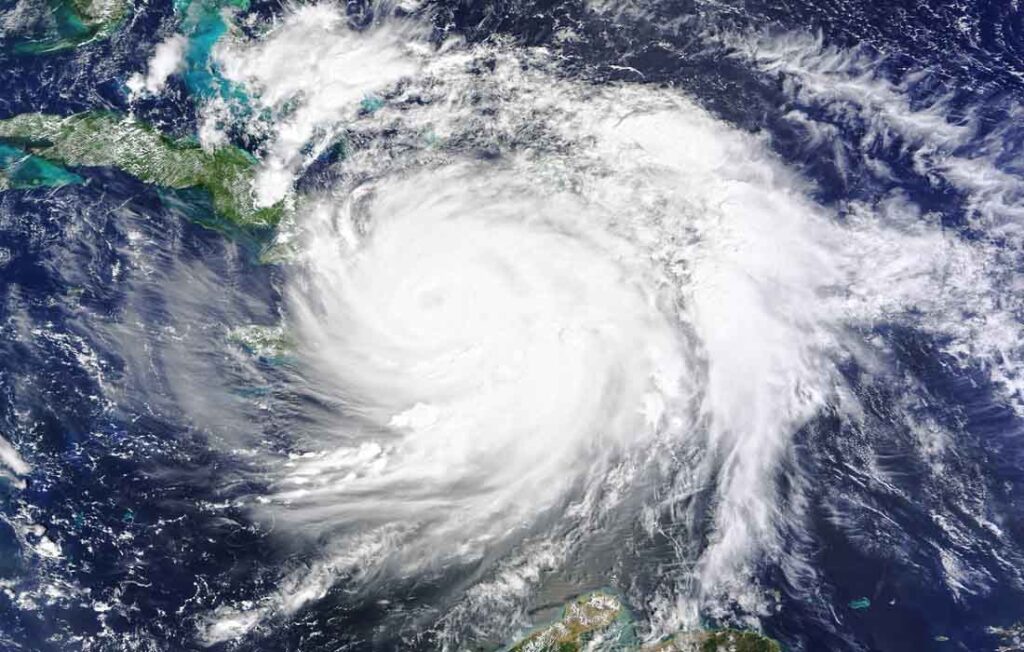Whether you live in a coastal state that experiences hurricanes or you’re located in the middle of the country, it’s critical to learn about these massive storms and how they can forever alter the environment around us. Most people are aware of the significant hurricane damage that is done to homes, businesses, and other man-made structures, but how does it affect the delicate balance of ecosystems? And what are the economic consequences?
We’re talking about one of the world’s most powerful natural disasters, its environmental impacts, and the nonprofits working diligently every day to help mitigate the effects of these storms for both humans and the environment.
What Is a Hurricane?
A hurricane, more specifically known as a tropical cyclone (“tropical” because it forms over warm, tropical waters), is a low-pressure weather system that rotates counterclockwise in the Northern Hemisphere (clockwise in the Southern Hemisphere). These storms are characterized by thunderstorms with no weather front in addition to wind speeds of 74 miles per hour (mph) or higher.
Forming over the Atlantic Basin (this includes the Atlantic Ocean, Gulf of Mexico, Carribean Sea, and occasionally the North Pacific Ocean), once a tropical cyclone has been identified, it is then categorized using the Saffir-Simpson Hurricane Wind Scale which rates the storm from 1 to 5. This rating can change as the storm moves, grows, or decreases in strength. A Stage 5 hurricane is the most powerful and dangerous with wind speeds measuring at 157 mph or higher. For both Stage 4 and Stage 5 storms, catastrophic damage is expected to occur.
How Do Hurricanes Form?
When an elongated low-pressure system (known as a “tropical wave” because of its wave-like appearance on meteorology charts) moves west through the tropics, it draws warm air up from the ocean’s surface. This warm air then cools in the higher atmosphere, creating storm clouds. As more warm air rushes to take the place of the already-risen air, a swirling pattern begins to take shape. Winds pick up speed and a hurricane is formed.
According to the National Ocean Service, “During just one hurricane, raging winds can churn out about half as much energy as the electrical generating capacity of the entire world, while cloud and rain formation from the same storm might release a staggering 400 times that amount.”
Hurricanes begin to weaken and dissipate when they are no longer able to draw up warm air energy from the ocean below. While it is certainly possible for storms to peter out over the ocean, the most common example (as witnessed by humans) is the weakening of these storms once they’ve reached land, often transforming into tropical storms. Yet, despite this weakening, the damage they can do is immense.
When Is Hurricane Season?
Hurricane season stretches between the months of June and November. Historically, the U.S. states with the most hurricane activity include Alabama, Florida, Georgia, Louisiana, Massachusetts, Mississippi, New York, North Carolina, South Carolina, and Texas.
The Pacific Ocean has its own hurricane season, which starts slightly earlier on May 15. While Pacific Island nations and Hawaii have been affected by these storms in the past, the West Coast of the continental United States has never been hit by a Pacific hurricane.
To learn more about hurricane season where you live and the potential effects it may have, you can follow news from NOAA and the National Hurricane Center.
Damage, Cost, and the Environment
Historically, hurricanes are the most deadly and destructive of all natural disasters, costing the United States federal and state governments more than two trillion dollars over the past 30 years. From rebuilding infrastructure and utilities such as roads, power, gas, water, and sanitation to removing waste, debris, and displaced sediment—not to mention the cost of rebuilding homes and businesses—the reparations required after these storms are diverse and extensive.
And this list doesn’t even address the damage done to the environment.
The strong winds and flooding characteristic of hurricanes uproot plants and remove foliage from treetops, damaging ecosystems in wooded areas. Fish and other aquatic animals are killed or displaced as flood waters spread, destroying the traditional breeding grounds of these animals. Other land-based wildlife is killed or displaced as animals attempt to find higher ground; their own hunting, grazing, and breeding grounds destroyed. Meanwhile, invasive plant and animal species can be relocated to habitats more susceptible to their influence, threatening long-term damage. Sediment is moved, creating entirely new habitats and significant shoreline erosion causes existing habitats to shrink rapidly (such as the Louisiana barrier island wetlands).
And that is only the beginning of the dangers posed by flood waters.
When passing over and damaging toxic sites like landfills, mines, and industrial plants, flood waters can pick up dangerous amounts of pollutants. These waters can also carry with them disease and bacteria, infecting both humans and animals.
The truth is, when our ecosystems are weakened or destroyed in this way, nature no longer has a way to protect or support humans against other disasters. Drought, fire, increased flooding, mudslides—all natural disasters that are known to increase after a hurricane. This costs even more money and negatively impacts communities that are already struggling to rebuild.
So how much of the two trillion dollars mentioned above has historically gone to environmental repair and conservation? Well, according to many federal disaster relief programs, the budget for these efforts (if mentioned at all) is “subject to the availability of funds,” meaning that no dollars are specifically allocated toward this work.
Until this changes, how can you help?
Nonprofits Aiding in Hurricane Recovery Efforts
Nonprofits across the country and around the globe are working to help mitigate the effects of natural disasters on our environment. We’ve identified six organizations within the EarthShare Nonprofit Network who are making efforts to ensure healthier, strong habitats, clean water, and disaster-resistant ecosystems in areas at risk for hurricanes.
From studying impact to conducting post-hurricane restorations, these organizations are dedicated to strengthening, protecting, and repairing the environment in order to support the health and wellness of nature and humankind alike. Check them out below.
Friends of the Everglades’ mission is simple: to preserve, protect, and restore the Everglades, a critical bioregion—not just for Florida, but globally. From encouraging and supporting environmental protections and legislation to educating and spreading awareness about the Everglades, Friends of the Everglades strives to protect this region, which is highly susceptible to hurricanes and hurricane damage.
American Rivers advocates nationally for clean water and healthy ecosystems—both of which support thriving communities. The brightest minds in water conservation, both nationally and locally, have come together to protect and maintain more than 150,000 miles of rivers nationwide (so far). These efforts include reducing flood vulnerability posed by sudden significant rainfall and natural disasters like hurricanes.
Everyone deserves safe access to the outdoors, and that’s the focus of Florida Trail Association, which maintains more than 1,500 miles of Florida nature trails. Due to the susceptibility of these trails to hurricane damage, the Florida Trail Association addresses debris clean-up as well as safety assessments after every major storm, contributing to the critical repair of key ecosystems.
The goal is simple: address wildlife, water, and climate change in order to support a healthy and thriving Florida. Florida Wildlife Federation unites conservation with education, helping to preserve endangered ecosystems (such as coastal salt marshes)—especially those susceptible to hurricane damage—and teaching Floridians and Non-Floridians alike why these habitats are so critical.
The National Audubon Society focuses on the protection and care of birds throughout the United States through efforts that address climate, coasts, water, and land. Both migratory and non-migratory birds are frequently placed at risk by dangerous and powerful storms, such as hurricanes, that can do catastrophic damage to habitats. By tracking birds using “community science,” the Audubon Society can learn more about how hurricanes fully impact these creatures and what can be done to help protect them.
A healthier ocean supported by a just world—sounds nice, right? Ocean Conservancy advocates for the health and wellness of our global oceans, inspiring people to take action and protect the world’s biggest resource. Knowing how hurricanes affect marine life, destroy coral reefs, and cause flooding, the Ocean Conservancy is able to better support these needs post-storm.
Moving Forward
Enviornmental conservation and protections are critical after a huge storm to help repair damaged ecosystems. Unfortunately, it’s not something that is often given much (if any) budget by state and federal governments. To help with environmental recovery after a hurricane, check out the six nonprofit organizations above.
Know of a nonprofit that should be on this list? Let us know by emailing our team at nonprofits@earthshare.org!




